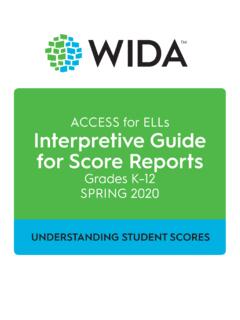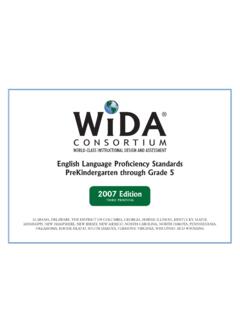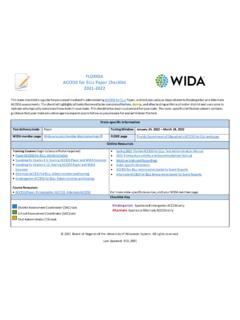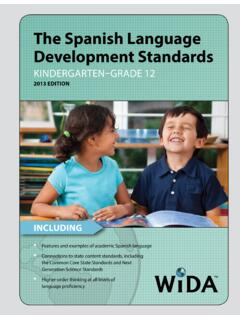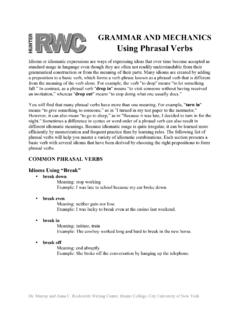Transcription of WIDA Speaking and Writing Interpretive Rubrics
1 WIDA Speaking and Writing Interpretive RubricsFeatures of the RubricsThe WIDA Speaking and Writing Interpretive Rubrics are analytic scales that help educators understand what students Speaking and Writing sounds and looks like at various levels of English language proficiency. Describing spoken and written language is a complex task. WIDA uses the terms dimension and proficiency level to describe various aspects of spoken and written language. WIDA has identified three dimensions and six proficiency levels. The dimensions are discourse dimension, which describes linguistic complexity ( , how connected are the ideas, how detailed are the facts, how appropriate is the register?)
2 Sentence dimension, which describes language forms ( , how varied are the sentence patterns, how fluid is the phrasing, how complex are the structures?) word/phrase dimension, which describes vocabulary usage ( , how specific are the word choices, how appropriate are the words to the context?) The six levels of English language proficiency are 1-Entering, 2-Emerging, 3-Developing, 4-Expanding, 5-Bridging, and 6-Reaching. They describe the trajectory of language development that students typically follow over time. In the Interpretive Rubrics , the dimensions of academic language development work together to describe speech or written text at each proficiency level.
3 Look at the rubric shown below. Notice the comprehensibility bar at the top of each language proficiency level description. The two bullets under each dimension name specific criteria or features associated with student responses at each language proficiency level, for that Speaking Interpretive rubric Grades 1-12 Discourse LevelSentence LevelWord/Phrase LevelLinguistic ComplexityLanguage FormsVocabulary UsageLevel 6 ReachingResponse is fully comprehensible, fluent, and appropriate to purpose, situation and audience; comparable to the speech of English proficient students meeting college- and career-readiness standards.
4 Characterized by: sustained, connected oral language characterized by confidence, coherence, and precision in the expression of ideas tailored to purpose, situation, and audience clear evidence of consistency in conveying an appropriate perspective and register a full range of oral phrase and sentence patterns and grammatical structures matched to content area topics controlled, skilled use of oral language to convey meaning , including for effect consistent usage of just the right word or expression in just the right context related to content area topics facility with precise vocabulary usage in general, specific, or technical languageLevel 5 BridgingResponse is comprehensible, fluent, and generally related to purpose; generally comparable to the speech of English proficient peers.
5 Characterized by: sustained, connected oral language that shows appropriate and coherent expression of ideas related to purpose, situation and audience clear evidence of conveying an appropriate perspective and register a broad range of oral phrase and sentence patterns and grammatical structures matched to the content area topic controlled, fluid use of oral language to convey meaning , including for effect usage of technical and abstract content-area words and expressions as appropriate usage of words and expressions with precise meaning related to content area topics as appropriate vocabulary usage that fulfills the Speaking purposeLevel 4 ExpandingResponse is generally comprehensible, fluent, and related to purpose.
6 Characterized by: connected oral language that supports the expression of expanded or related ideas through emerging coherence, detail and clarity some evidence of conveying an appropriate perspective and register a range of oral phrase and sentence patterns and grammatical structurescharacteristic of the content area generally controlled and fluid use of oral language to convey meaning usage of specific and some technical content-area words and expressions as appropriate usage of words and expressions with multiple meanings or common idioms across content areas as appropriate vocabulary usage that generally fulfills the
7 Speaking purposeLevel 3 DevelopingResponse is generally comprehensible (though comprehensibility and fluency may from time to time be compromised in more complex speech); characterized by: oral language that shows the development of connected language in the expression of an expanded idea or multiple related ideas evidence of a developing sense of perspective and register developing range of oral phrase and sentence patterns and grammatical structures common to content areas developing control in use of oral language to convey meaning usage of some specific content words and expressions as appropriate usage of words or expressions used frequently in content areas.
8 As appropriate vocabulary usage that attempts to fulfill the Speaking purpose Level 2 EmergingResponse is generally comprehensible (though comprehensibility and fluency may often be compromised in more complex speech); characterized by: oral language that shows emerging expression of ideas; some attempt at connecting ideas may at times be evident some amount of language that may be repeated from the prompt chunks of language, repetitive oral phrase patterns, and formulaic grammatical structures used in social and instructional situations or across content areas variable control in use of oral language to convey meaning usage of general content words and expressions usage of social and instructional words and expressions across content areas possible usage of general vocabulary where more specific language is neededLevel 1 EnteringResponse is generally comprehensible (though comprehensibility and fluency may be significantly compromised in language beyond)
9 Words, oral phrases, or memorized chunks); characterized by: words, oral phrases, or memorized chunks of oral language used to represent ideas varying amounts of language that may be repeated from the prompt words, chunks of language, or simple phrasal patterns associated with common social and instructional situations occasional control in use of oral language to convey meaning usage of highest frequency general content-related words usage of everyday social and instructional words and expressionsDimensions of academic language developmentLevels of English language proficiencyComprehensibility bar8/11/2017{Wisconsin Center for Education ResearchUniversity of Wisconsin Madison | 1025 West Johnson St.}
10 , MD #23 | Madison, WI 53706 Client Services Center toll free: | for the RubricsThe WIDA Speaking and Writing Interpretive Rubrics are tools for teachers who work with English language learners (ELLs) in Grades 1-12. Teachers can use these Rubrics for three primary purposes. Understanding ACCESS for ELLs Speaking and Writing scores Analyzing student Speaking and Writing samples Interpreting common Speaking and Writing tasksThe following are suggestions for rubric #1: Understanding ACCESS for ELLs Speaking and Writing ScoresStudents take ACCESS for ELLs every year.
